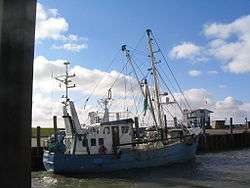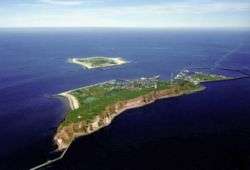Nordstrand, Germany
![]()
Nordstrand di Ströön | |
|---|---|
 | |
Location of Nordstrand di Ströön within Nordfriesland district | |
 Nordstrand di Ströön  Nordstrand di Ströön | |
| Coordinates: 54°29′0″N 8°53′0″E | |
| Country | Germany |
| State | Schleswig-Holstein |
| District | Nordfriesland |
| Municipal assoc. | Nordsee-Treene |
| Government | |
| • Mayor | Jens-Johann Jacobsen (CDU) |
| Area | |
| • Total | 57.43 km2 (22.17 sq mi) |
| Elevation | 2 m (7 ft) |
| Population (2018-12-31)[1] | |
| • Total | 2,241 |
| • Density | 39/km2 (100/sq mi) |
| Time zone | CET/CEST (UTC+1/+2) |
| Postal codes | 25845 |
| Dialling codes | 04842 |
| Vehicle registration | NF |
| Website | www |
In medieval times, Nordstrand was a part of the larger island of Strand which was torn into pieces in a disastrous storm tide in 1634. Over 6,000 people drowned. Before 1634, the area of the island was about 210 square miles (540 km2).[3] Other remnants of Strand are Pellworm and the Halligen islets.
Nordstrand is accessible by road over a causeway which connects to the mainland and was built in 1936. In 1987, the polder Beltringharder Koog was completed, turning the former island into a peninsula.
North American emigrants who used it as a surname
The original Nordstrand island (before the flood of 1634) is thought to be the ancestral homeland for the North American surname "van Nostrand" (including variants: vanNostrand, vanNordstrandt, vanOstrand). Two brothers emigrated from here to what is present day New York, USA in 1637 and 1638 after the flood. One of the three granite panels of the Canadian van Nostrand monument, located in York Mill's Cemetery, Toronto (St. Johns, York Mills, Anglican Church, 19 Don Ridge Dr., North York, Toronto, Ontario) points to Nordstrand Island.
Pieter Karstense van Nortstrant was born about 1605 on the island of Norstrand. Coupled with the name of his father, Carsten or Kersten, and the fact that his children were baptized in the Lutheran Church in Amsterdam, it would seem that a German, Frisian or Danish origin is probable. It is uncertain when Pieter Karstense came to Amsterdam, possibly as a child with his father, though no record of the latter has been found there. The sons of Pieter Pietersen Ostrander (son of Pieter Karstense van Nortstrant), were called Van Norstrande or Van Nostrande, while Van Ostrande was used in other baptisms and eventually adopted the surname Oostrander and then the spelling as it is today Ostrander.[4]
Local alcoholic beverage
Nordstrand is the origin of a locally famous alcoholic beverage, the Pharisäer ("Pharisee"), which the islanders developed in 1872 to be able to drink alcohol in the presence of local pastor Georg Bleyer, who preached abstinence. It is made from strong hot coffee, sugar, dark rum (4 cl of 54 %vol) and whipped cream (to prevent the alcohol from evaporating, so that it could not be smelled). The pastor got the only cup without rum, but one day the cups got mixed up. When he discovered the deceit he exclaimed "Ihr Pharisäer!" ("You Pharisees!", connoting: "hypocrites"). Hence the name.[5][6]
See also
- Jan Adriaanszoon Leeghwater, Dutch hydraulic engineer
References
- "Statistikamt Nord – Bevölkerung der Gemeinden in Schleswig-Holstein 4. Quartal 2018 (XLS-file)". Statistisches Amt für Hamburg und Schleswig-Holstein (in German).
- Nordfriesland-Karte, Nordfriisk Instituut, Bräist/Bredstedt 2011, ISBN 978-3-88007-371-5
- Rines, George Edwin, ed. (1920). . Encyclopedia Americana.
- "PATRONYMICS AND SURNAMES". Ostrander Family Association. Retrieved 5 June 2012.
- Jysk Ordbog (in Danish)
- Jyllands-Posten Archived 2006-11-17 at the Wayback Machine which dates this event to 1873 (in Danish)
External links
| Wikimedia Commons has media related to Nordstrand, Germany. |
